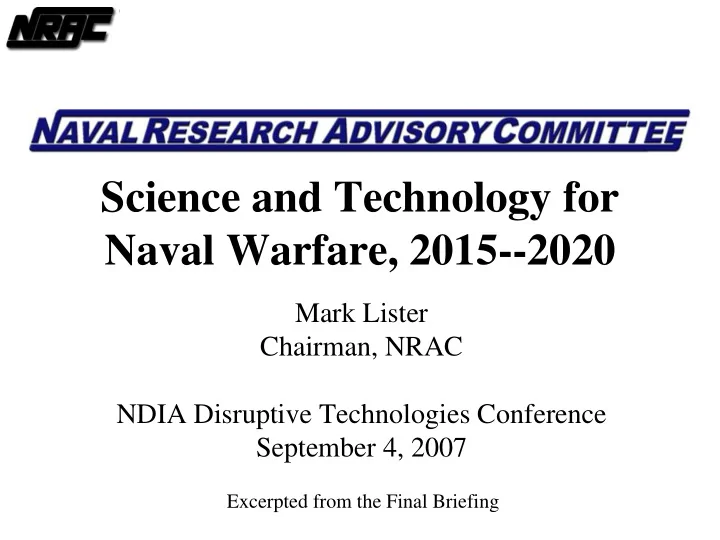

Science and Technology for Naval Warfare, 2015--2020 Mark Lister Chairman, NRAC NDIA Disruptive Technologies Conference September 4, 2007 Excerpted from the Final Briefing
Outline Terms of Reference Panel Membership Briefings & Discussions Global S&T Trends Military Implications U.S. Navy-Marine Corps in 2020 Threats to U.S. Forces Mission+Threats+Technologies Matrix Counter-Threat Technologies Investments Mission-Enabling Technologies Investments Overarching Issues Requirements Conclusion 2 Recommendations
Global S&T Trends/1 • Continued asymmetric opposition to U.S. interests – Non-state actors – Nation states – Military actions – Against U.S. critical infrastructure – Against U.S. civilian population • Continued dilution of U.S. S&T base – Foreign students outnumber Americans in advanced engineering and science curricula – Technical education losing to business, arts – Government laboratory positions less attractive – Foreign investment in technical education accelerating 3
Global S&T Trends/2 • Globalization eroding U.S. technical dominance • Impending oil availability crisis – U.S. dependence on Middle East oil – Near-term Chinese demand for oil – Mid-term EU, Indian demand for oil – Changing situation in Venezuela • Increasing U.S. dependence on foreign technology • Worldwide access to advanced technology through foreign and U.S. sales and espionage • Technological surprise is probable! 4
Military Implications of the World of 2020 for S&T /1 This study makes no attempt to define the future or to draw possible scenarios for what the world will look like in 2015-2020. However, certain trends are obvious: • Nuclear, chemical, bio weapons continue to proliferate • Terrorism continues • Increasing violence and political influence by non-state actors • Proliferation of primitive (but effective) as well as modern weapons/systems – Improvised explosive devices – Man-portable air-defense missiles – Sea mines – Surface-to-surface missiles 5
Military Implications of the World of 2020 for S&T/2 • Growing foreign economic power and changing politics – Rapidly changing demographics – Major emphasis on advanced S&T education – Advanced weapon development and sales • Development of significant regional military powers – Blue water navies: China, India – Regional navies: Iran 6
Navy-Marine Corps Missions in 2020 Many missions are similar to the Cold War era BUT with significantly different emphasis � Provide seaborne missile defense � Provide seaborne support for operations against terrorism (including homeland defense) � Protect U.S.-Allied maritime areas of interest (inc. SLOCs) � Project military power (presence/rescue/peacekeeping/ strike/assault) � Threaten military forces of potential enemies (especially their WMD capabilities) � Deter nuclear attacks (Trident SSBNs) 7
Threats Impacting Navy-Marine Corps Missions/1 • Increased availability of long-range weapons against naval- maritime formations – Ballistic missiles with terminal guidance – High-speed, sea-skimming cruise missiles – EM Guns • Proliferation of nuclear, chemical, biological weapons • Proliferation of inexpensive delivery systems and weapons, including – Air (UAVs, mini-UAVs) – Surface (USVs) – Underwater (UUVs, mines, mini-submarines, SDVs) – Land mines, IEDs, and other low-tech systems – MANPADS, laser devices, and other high-tech systems 8
Threats Impacting Navy-Marine Corps Missions/2 • Proliferation of advanced submarine technologies and concepts of operation – Propulsion – Sensors – Stealth – Weapons • Proliferation of capabilities for sophisticated information warfare • Increase in vulnerabilities of U.S. logistics – Pipeline – Overseas procurement of goods and services 9
Threats Impacting Navy-Marine Corps Missions/3 • Near-continuous surveillance of U.S. land and sea forces by opposing military and commercial satellites, “cheap” UAVs, and other means • “Network centricity” creates vulnerabilities for U.S. forces – Interruption/jamming – Effective EMCON impossible – Information overload – Over-dependence on reachback • Loss of low-observable effectiveness • Reliance on GPS makes it a major target 10
Technology Traceability to Navy Marine-Corps Missions 11
Technology Traceability to Missions Indexed by Threats 12
Technology Traceability to Counter-Threat Technologies 13
Technology Traceability to Mission-Enabling Technologies 14
Technology Traceability to Missions and Threats 15
Findings/1 Counter-Threat Technologies Investments • Tactical/Operational – Active acoustic systems – Discrimination and clutter rejection – False target generation for deception – GPS deep-fade technology – GPS alternative • Logistics – Security for overseas supply chain • Capabilities/Systems Development – Foreign S&T awareness – Formal, automated methods for Verification, Validation, and Accreditation – Information assurance 16
Findings/2 Mission-Enabling Technologies Investments • Tactical/Operational – Advanced AAW – Coordinated, multimode ASW – Effective C 2 in EMCON – Offensive mine warfare – Pattern recognition and anomaly detection – Robust offensive information warfare – Upstream information fusion • Capabilities/Systems development – Antenna technology – Environmental sciences (specific areas) – Low-cost platforms technologies 17
Findings/3 Overarching Issues Requirements • Formal mechanism for assessing U.S. vulnerabilities • Fundamental understanding of COTS – Business models – Technology drivers – Standards – Internal structure, functionality, vulnerabilities • Long-term program to develop S&T workforce • Improved coordination of R&D programs • Requirements-linked, long-range planning process for S&T investment strategy • NRAC long-range S&T review should be a continuing responsibility 18
Conclusion/1 The bottom line is that While the Navy has a productive S&T program today…. The rapidly changing threat and the rate of world technological development demands change in the Navy-Marine Corps investment strategy for S&T over the next 15 years to insure that the naval services can continue to effectively carry out their missions. 19
Conclusion/2 Failure to change the investment strategy for Navy-Marine Corps S&T will make technological surprise on the battlefield likely …and success in executing naval missions will be problematic. 20
Recommendations • Develop Long-Term S&T Planning Process • Develop Long-Term S&T Workforce Plan • Accelerate Lower-Cost Platform Technologies • Assess and Mitigate Long-Term COTS Vulnerabilities 21
“Disruptive Application” Observations • Christensen: Disruptive Technology to Disruptive Innovation • Time to migrate to “Disruptive Applications” – Not necessarily based on Disruptive Technology – Inexpensive, easily accessible, unanticipated asymmetric capabilities • Know thy enemy – Today’s and tomorrow’s – Culturally, mentally, emotionally, technologically • We have a Disruptive Technologies Office…do we need a Disruptive Applications Office? – Proactive vs. reactive 22
Recommend
More recommend